What a wild month May was for Central Texas. Heavy rains caused severe and deadly floods in a number of cities and smaller communities in Texas, including my own. Along with the bad, some good happened too: in most areas of Texas, the drought of these past eight years is declared “over”. The downside, of course, is that the drought ended with massive rain “bombs” which exacted a high cost in lives and property. So far, 27 people are confirmed dead, with several still missing. The property damage is estimated at least $27 million.
I’ve continue to hear that 35 trillion gallons of water fell on Texas in May. While I’m not quite sure how that’s measured (buckets?)–it’s a lot of rain. Here in Austin, the official rainfall total was 17.59 inches for May, compared the the “normal” of 4.37 inches.
Yup, lots of rain.
Texas weather is dramatic, to say the least. As National Public Radio’s Texas reporter extraordinaire, John Burnett, stated in one of his stories last week about the disastrous Texas floods: It seems to affirm a quote attributed to a meteorologist in 1927. Texas is a land of perennial drought broken by the occasional devastating flood.
Wildlife perseveres through it all though. Native flora and fauna have developed mechanisms to thwart, or at least, mitigate, nature’s challenges, be it drought or flood, and all other things being equal, will recover–in time.
Early in the month, there was plenty of wild and honeybee activity on native blooms in my gardens. I fear that some of the ground nesting native or wild bees that live in and around my garden were flooded out, but mason and wood nesting bees continue, mostly unmolested, by the rains. There will probably be a dearth smaller metallic, sweat and other ground nesting bees for a time, until their populations rebound. My gardens will be ready for them when the next generation emerges.
I identify bees (and other insects and birds, for that matter) by visually comparing my photo(s) with an example found on a legitimate website like bugguide.net or The Jha Lab of The University of Texas–assuming I can find a photo, that is. Then I research whether the critter-of-choice photographed elsewhere visits the same or similar plant species–or if there’s any related information on feeding or behavior. I usually confirm with at least one more reference, if possible. If I can draw a connection, either by physical similarity and/or behavior, to what I’ve seen in my gardens, combined with information gleaned on scientific websites, I feel reasonably confident about my identifications. As I’m only just learning about the multitudes of native bees in Texas (300-plus species), keep in mind that my identification of wild bees are worth what you paid for them. Come to think, that probably holds true for most of the insects I name.
You’ve been warned.
This is a Miner Bee, Perdita ignota, I believe. During the first weeks of May, several crawled around the Engelmann or Cutleaf Daisy, Engelmannia peristenia, blooms, ending up covered in pollen–which is typical of the way bees, especially wild bees, cross-pollinate so efficiently.
I haven’t seen any adults for a couple of weeks and because these particular bees ground nest, I’m guessing that some nests were flooded out with heavy rain. Poor bees.
I like the sharing of flower-space between this very tiny bee and the Ladybird Beetle (one of the good guys).
But there’s an unwelcome visitor to the neighborhood in the guise of the Spotted Cucumber Beetle. These beetles certainly chomped their share of petals and leaves recently, which I’m not thrilled about. Squishing is my preferred method of destruction (yes, I wear gloves!), but honestly, they’re pretty quick-n-crafty, therefore uncatchable.
I think the bee on the flower left of the “Native Bee” label is a Minor Bee, but the tiny bee on the right is a mystery. It might a wasp or even a fly. But the body form looks bee-like to me: wider body, not so skinny, and no dangly-wasp legs. I’m sticking with a Teesny Bee ID.
I witnessed these two Ceratina ssp., Small carpenter bees, in the process of making more bees.
Blush.
After the untangling and with full pollen sacs, the female will have placed the eggs in wood or maybe masonry, then closed off the opening by packing with pollen and soil so that the eggs can hatch in privacy and protection. The larvae will develop as they eat the pollen, but it might be a while for the next generation pollinates and nectars–and creates more of the same.
In between rainstorms, this Eastern Carpenter Bee, Xylocopa virginiana, visited the Barbados Cherry.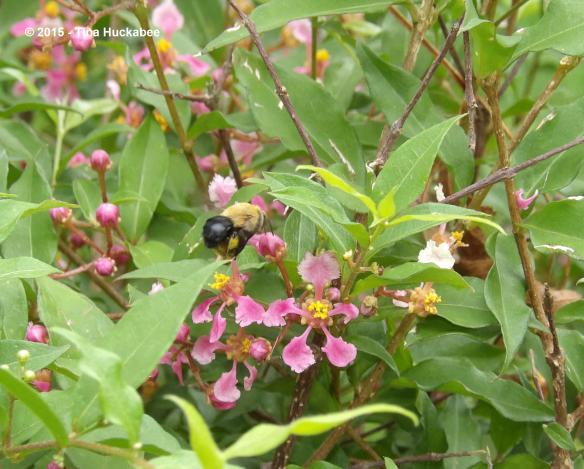
That’s quite a load, eh? There’s something comically cute about bees carrying pollen–I always smile when I see full pollen pantaloons, whether on my honeybee gals or native bees. And I wonder, How does she fly with that mass of pollen?
I guess she rests at some point. As I watched and photographed her, she was vibrating along the plant, near an open bloom. Native bees shake or vibrate to induce the flower to release pollen.
I think this one, sipping nectar at Purple Coneflowers, is a another Eastern Carpenter Bee, though her coloring is a little different.
Most of the carpenter bee species I’ve observed in my gardens are black with stripes or black with puffs of yellow, here and there. This gorgeous, shiny black bee (or maybe fly?) is pure, glistening black.
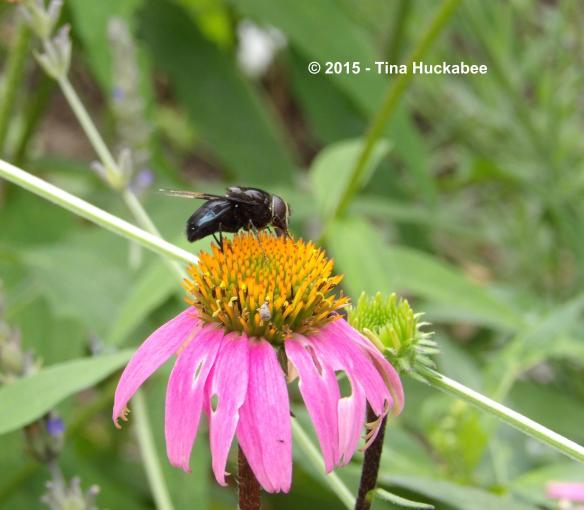 I couldn’t find a fly which meets this description, so I’m hazarding a guess at another carpenter bee species type. There are differences in coloration between males and females (on their faces) with carpenter bees, but, I’m stumped about this one. Any ideas? Fly or bee? Bee or fly? Shall we take a vote?
I couldn’t find a fly which meets this description, so I’m hazarding a guess at another carpenter bee species type. There are differences in coloration between males and females (on their faces) with carpenter bees, but, I’m stumped about this one. Any ideas? Fly or bee? Bee or fly? Shall we take a vote?
It doesn’t matter all that much to me because all pollinators are welcome in my garden.
The Syrphid Flies continued their love affair with the Engelmann or Cutleaf Daisy in my back garden.
Syrphidae, also known as Flower Flies, are great pollinators and are beautiful garden visitors. They come in a variety of color combos, but his yellow and brown is the one that I see most often and alights long enough for photographs.
Because of that, they are my favorite of the Syrphidae.
This fetching Long-legged fly, in the family Dolichopodidae, rested on the large leaf of a non-native Sunflower. Such a pretty fly, its metallic green color mirrors its chosen plinth.
Green Lacewing, Chrysopidae, insects are a personal favorite of mine.
So graceful and fragile looking, they are garden beneficials in larval and adult form. The larvae eat spider and insect eggs, as well as aphids. The adults feed on nectar and pollinate, as well as, adding crunch to their diet by consumption of smaller insects and eggs.
An influx of the Four-lined Beetle, Poecilocapsus lineatus, proved a problem in my garden this past month, especially on the foliage of the Cutleaf Daisy. The Four-lined Beetle is handsome in its suit of red-to-yellow stripes, but I don’t like what they do to MY plants.
These true bugs feed on foliage, sucking the juice of leaves, causing this stippling.
Other insects with sucking mouthparts cause discoloration to or rotting of foliage. Not friends to the garden, that’s for sure.
The butterflies and moths are making a comeback after the floods and ready for summer action, as witnessed by this Little Yellow, Pyrisitia lisa, feeding on a Four-nerve Daisy, Tetraneuris scaposa.
I used to see these interesting pollinators, Snowberry Clearwing Moth, Hemaris diffinis, frequently in my gardens,
 …but they’ve been scarce in the drought years. I was tickled to watch this one and hope to see more of them through the summer months.
…but they’ve been scarce in the drought years. I was tickled to watch this one and hope to see more of them through the summer months.
This Little Brown Grasshopper-thing, (actually, two different ones), have tooled around the Winecup, Callirhoe involucrata.
I gave up identifying this guy/gal–there are too many different grass and leafhoppers to narrow down an identity. I have one or two other things to do, you know. Whatever it is, I love the powder-sugar sprinkling of pollen grains and appreciated their cooperation for the photo shoot. The photo above doesn’t show damage on the Winecup, though the one below does. What I don’t know for certain is whether it was the grasshopper who was the villain or whether the grasshopper was in the wrong spot and at the wrong time, where the botanical crime was committed..
As for avian visitors, May was no slouch in that department.
During fall migration, I saw a male American Redstart, but due to his fast movements through the trees, I never got a good photo. I did, however, enjoy observing him for a day or two, before he headed southward. This female or immature male American Redstart, Setophaga ruticilla, flitted through my trees and shrubs for a week or two this past month.
There were several, actually and I think they’ve headed north–I haven’t seen any of these warblers in the last couple of weeks. I look forward to their return in September/October.
Finally, I was charmed by the antics of this Gray Catbird, Dumetella carolinensis, helping himself to my Brazos blackberries.
I feigned annoyance at his or her thieving, but I don’t mind wildlife sharing the garden bounty. I had a bumper crop of blackberries this spring and where this particular vine is located is an ideal spot for Gray Catbirds: it’s a tangle of various shrubs, including the blackberry vine, which provides shelter and respite. And blackberries.
I hope your gardens benefited from wildlife visitors this month and that you will join in posting for June Wildlife Wednesday. Share the rare or mundane, funny or fascinating, beneficial or harmful critters you encounter. When you comment on my post, please remember to leave a link to your Wildlife Wednesday post so readers can enjoy a variety of garden wildlife observations.
Happy wildlife gardening!

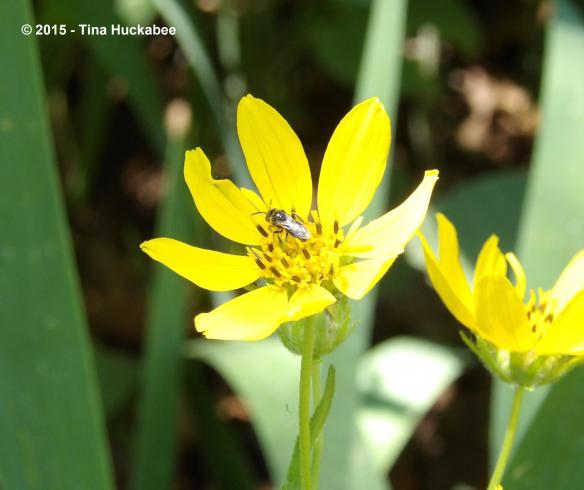
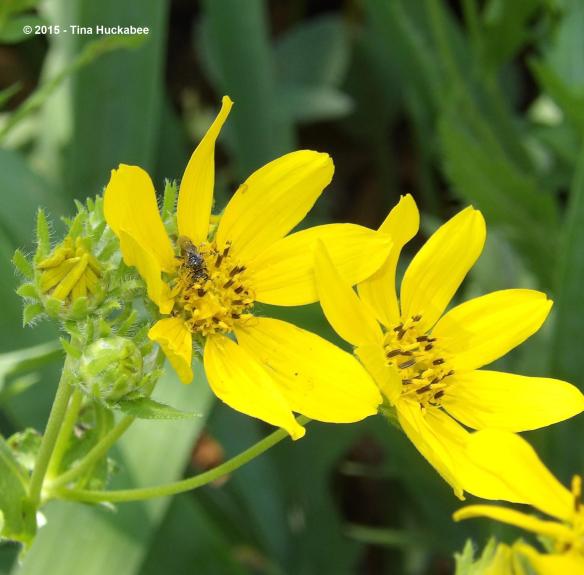
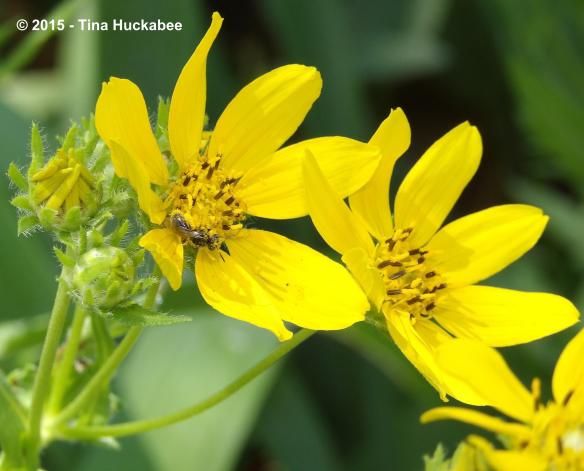
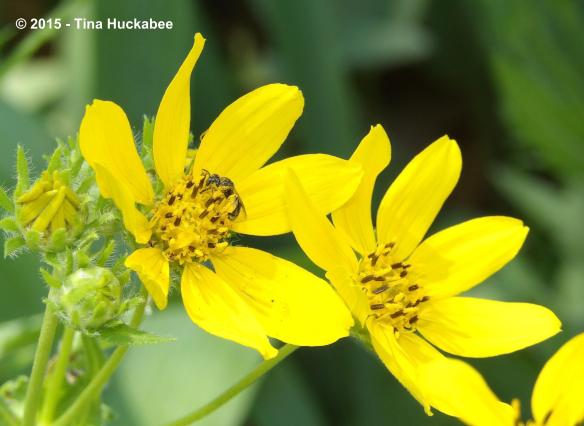
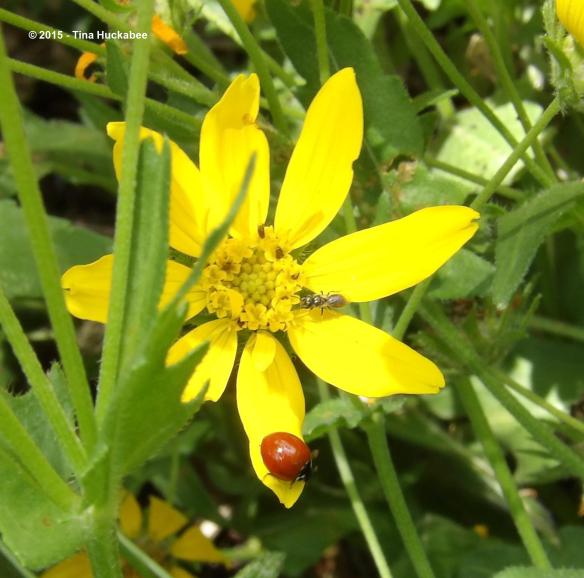

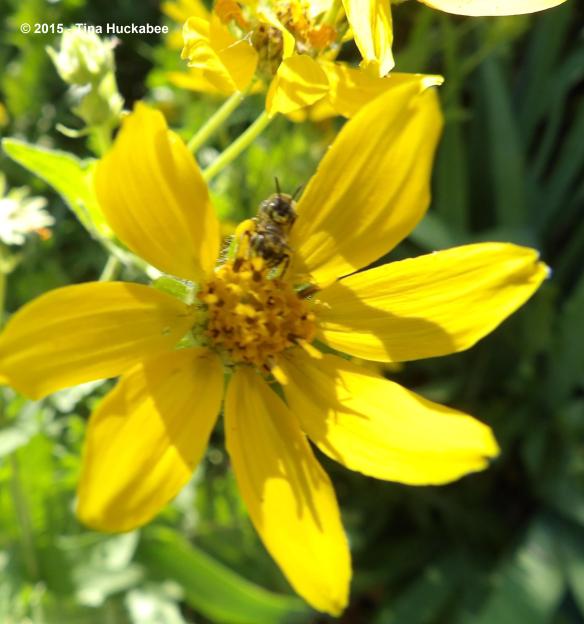

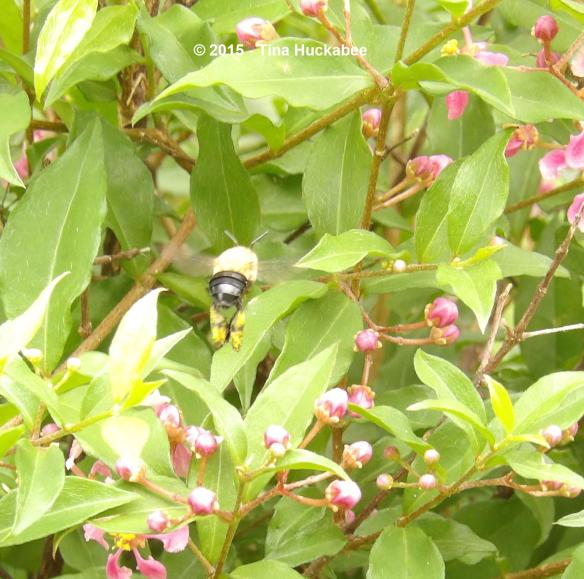
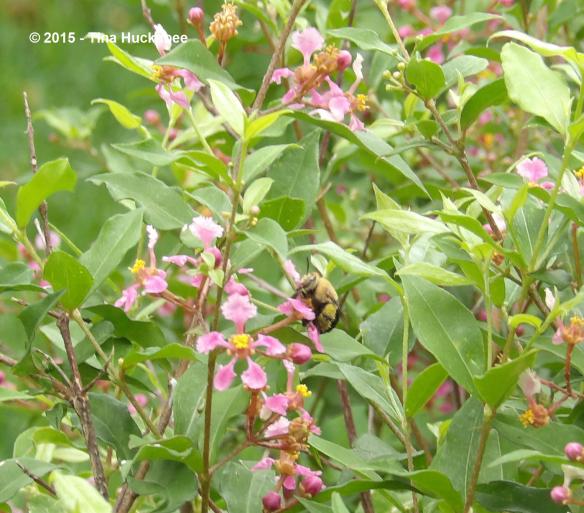
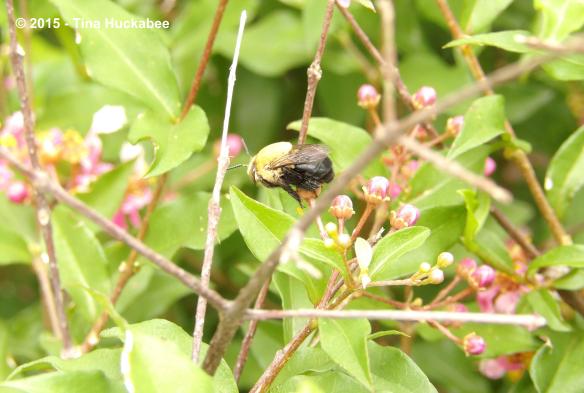
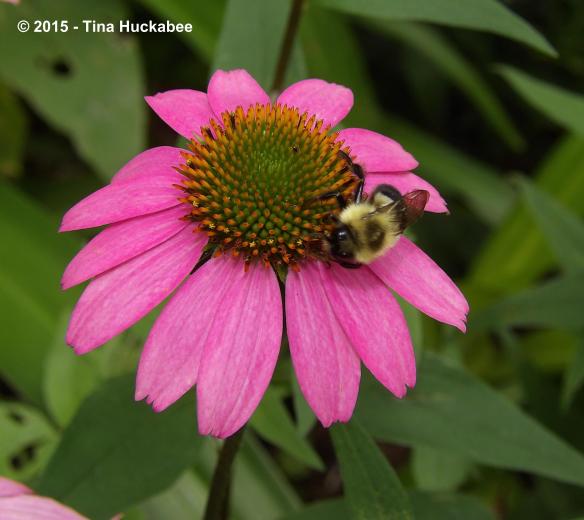

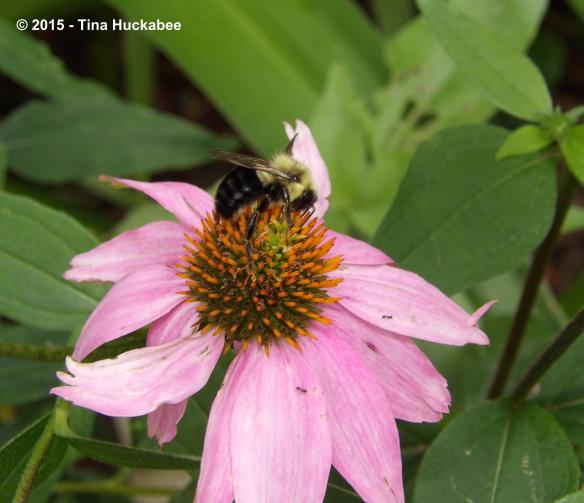
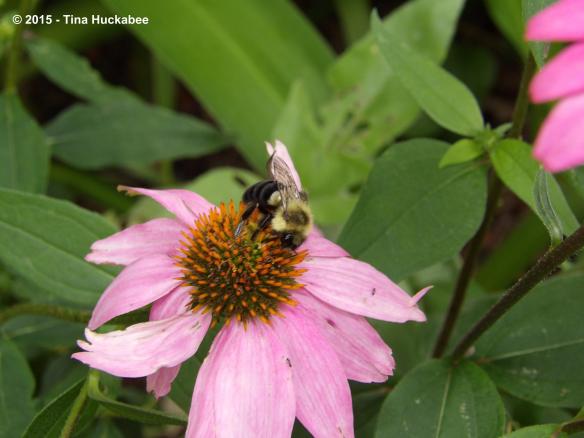
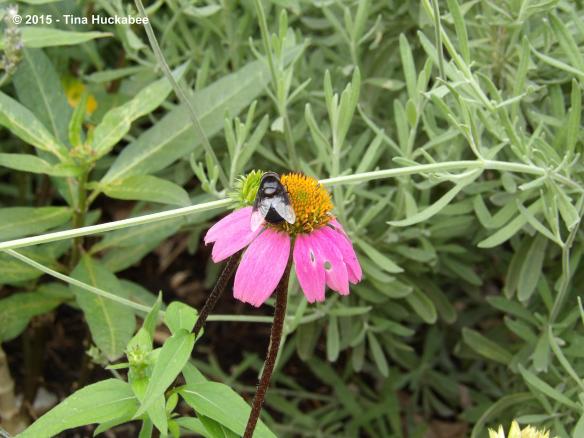

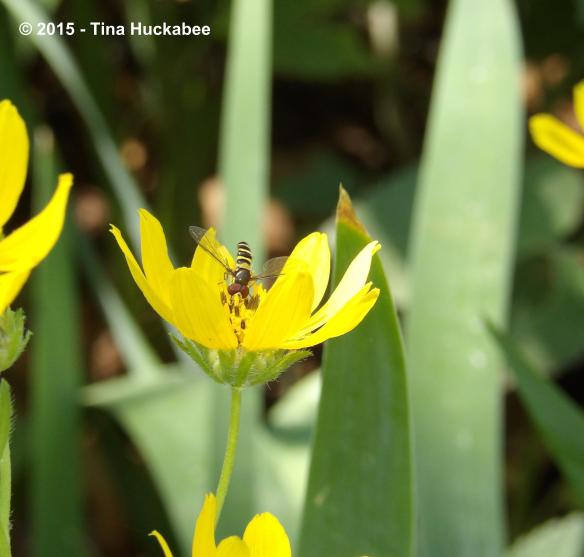
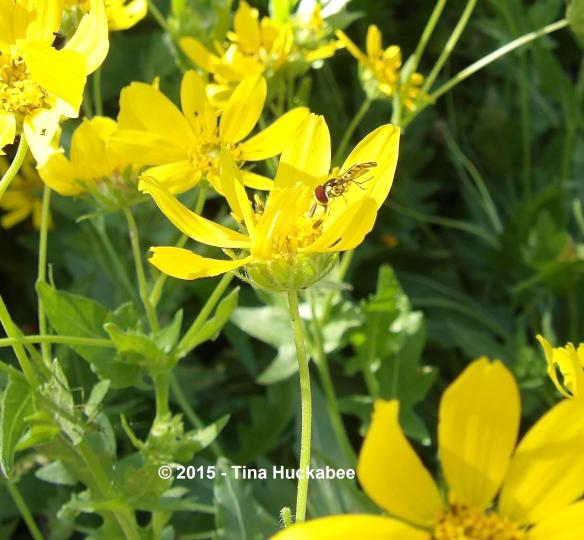
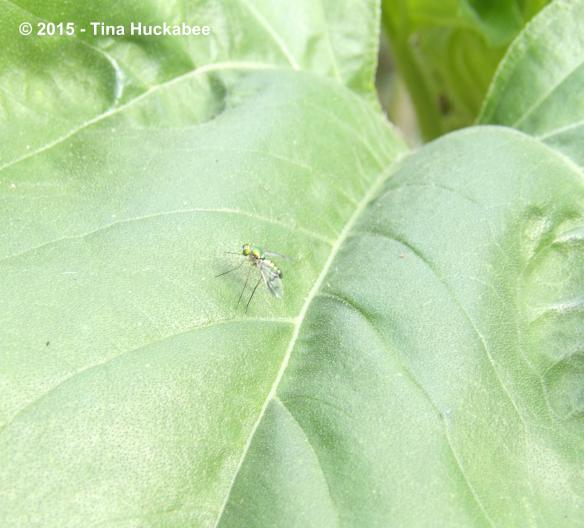
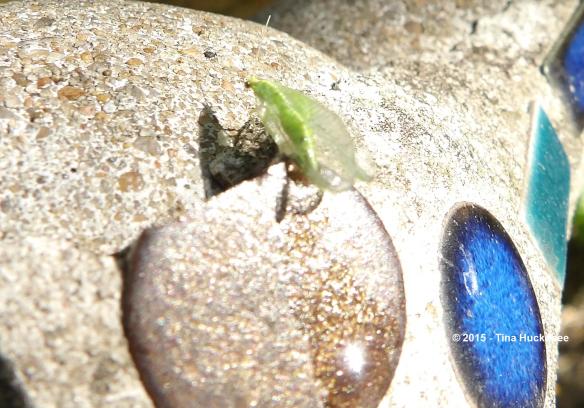
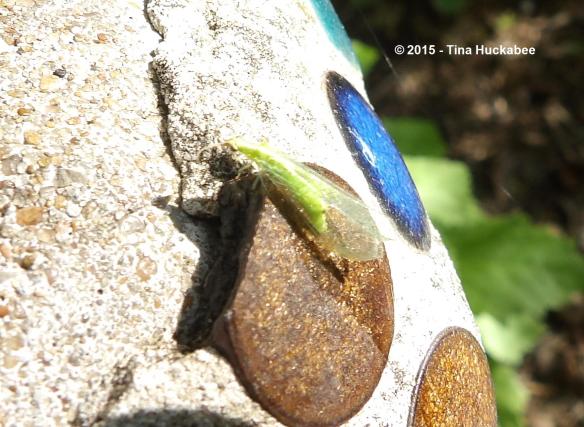
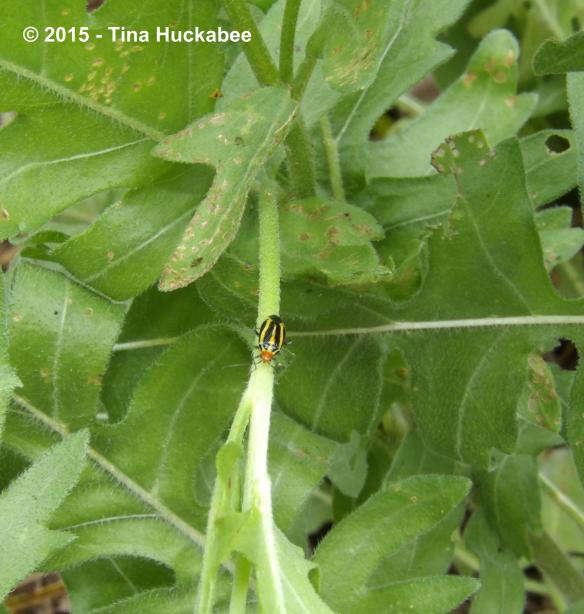
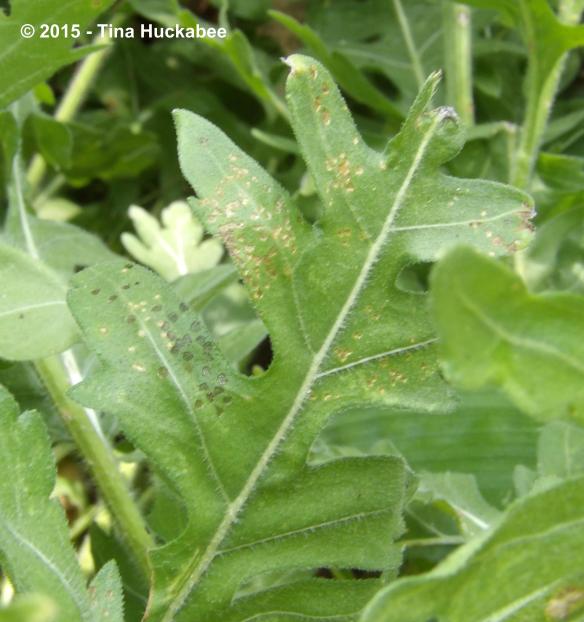
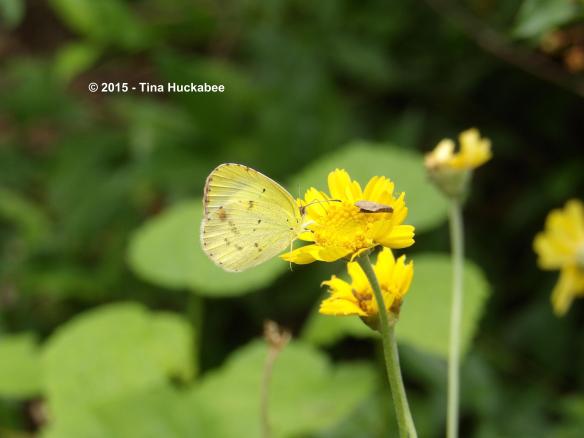
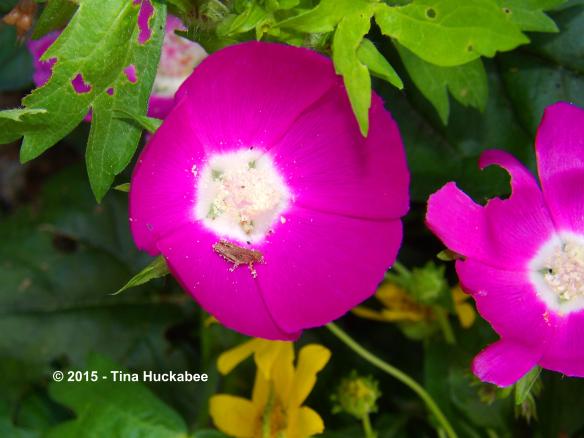
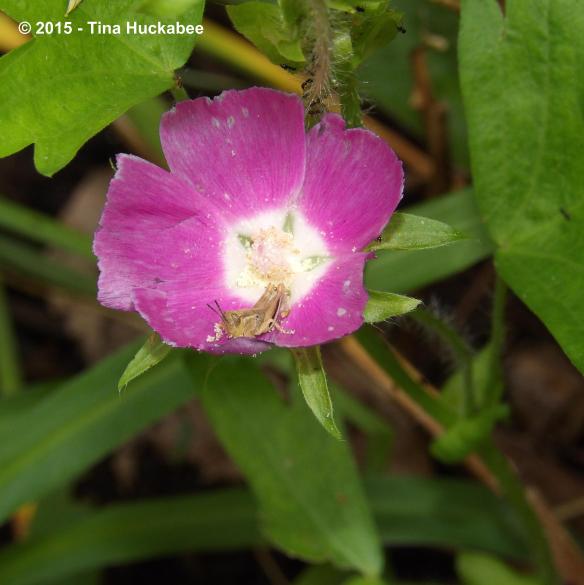


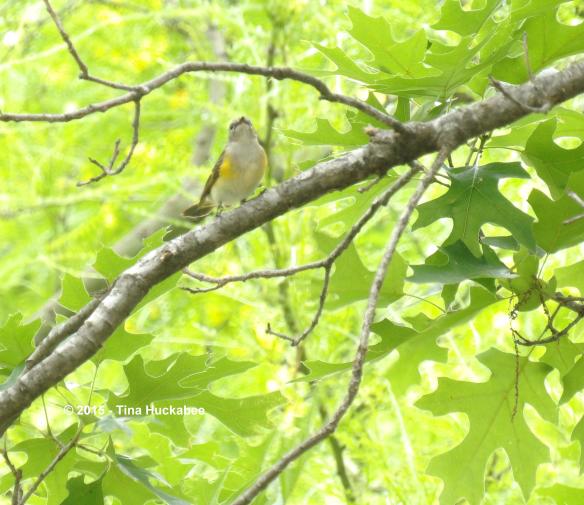

Thanks for sharing the lovely photos and information about your pollinators. It’s hard to imagine the impact of all that rain, but the silver lining of ending the drought is great. Happy Wildlife Wednesday!
LikeLike
Here’s my post: http://plantpostings.blogspot.com/2015/06/wordless-wednesday-peek-boo.html
LikeLiked by 1 person
I do love my pollinators. Thank you for participating in Wildlife Wednesay!
LikeLike
Great photos and I love the birds!
LikeLike
Thanks–I wish birds would stay still, just a bit longer for the photo shoots!
LikeLiked by 1 person
So much to take in this month – your spaces are busy no matter how wet (or dry!). All testimony to the great support a sturdy native habitat can provide as well as the caring nature of the resident gardeners (and bee keepers!).
Here’s my post for this month – slimmer pickings perhaps. I’m looking forward to seeing what everybody else has to report this month!
http://austinagrodolce.blogspot.com/2015/06/wildlife-wednesday-june-drips-dry.html
LikeLike
I’m glad I started this Wildlife Wednesday business–truthfully, I never realized just how much activity and life is in my garden. It’s been a great lesson for me.
LikeLike
Your garden really is full of pollinators. The floods sound dreadful for all the animals including the humans! Are you likely to get more rain now that you’ve had some or will this need to last another ten years?
LikeLike
There have been quite a variety of pollinators in my gardens. I attribute that to the variety of native plants that I grow and that I don’t use chemicals with my gardening. But maybe it’s just dumb luck. 🙂
It’s hard to say when the rain will return and whether we’ll slip back into a drought. The forecast is for a wetter-than-normal summer and fall rain pattern. There is an El Nino in the Pacific and that typically means more rain for the southwestern part of the U.S. That said, the rain in Texas and Oklahoma were record breakers. Is it climate change? That probably has something to do with the magnitude, though Texas does see spring flooding. It also doesn’t help that we allow overbuilding along river banks that are in flood zones and then are surprised when those flood zones…flood.
LikeLiked by 1 person
Pingback: Wildlife Wednesday: June 2015 | Under the Pecan Leaves
Very impressive diversity of bee species! I hope not too many of the ground nesters were lost to the floods. As for your bee/fly, I’m pretty sure it’s a fly. Flies have two wings (as does your critter), bees have four. Here’s a useful link. https://beespotter.org/topics/mimics/
LikeLike
Yeah, I realize about the wing difference, but I was thinking that in the photo, the underwings were tucked and therefore not visible. Truthfully, it does look more like a fly to me, but I haven’t seen it, or similar, since–it was a one-off deal, one afternoon. I’ll keep looking though and if I see it again, try for better photos and maybe a more accurate ID.
LikeLiked by 1 person
So beautiful — the flowers and their visitors. Several years ago I went to a master gardener event about insects. I asked about the four-lined plant bug which was ravaging one of my flower beds but the speaker didn’t seem to know much about them at the time. Since then I’ve heard more and more people complain about them. They do seem to be spreading rapidly through Texas. They love plants with aromatic resins which describes a whole lot of ornamental plantings here. I never even thought about what the floods meant for ground nesting bees. Yipes. I hope they can bounce back.
LikeLike
I’ve not had big problems with the four-lined bugs, but they are around. As for the ground nesters, they’ll probably rebound. If only floods were the only things that hampered them. Sigh.
LikeLike
Great post. I love your bees. By the time I get my camera focused on them they always manage to jump to the next flower! I think I’m becoming addicted to taking pics of insects. I’m to the point that I go out and shake the bushes to make them appear! Interesting stats about the rain. I’m so glad it’s over. I don’t know how they measure the rainfall either, but the other night on a news show it was stated that the amount of rain received in Texas during the month of May would cover the entire state in 8 inches of water, and would cover the state of Rhode Island in 10 feet of water! That’s quite something to think about.
I see lots of pictures of catbirds, but I don’t think I’ve ever seen one personally. Maybe we don’t have them, or maybe they blend in with other birds. Thanks for posting the various photos of your insects. You’ve helped me identify a few of mine! Here’s my post for this month —
Again and always, thanks for hosting!
LikeLike
Those little bees are hard to photograph. Really hard, I think.
I had heard that one too–enough rain to cover all of Texas in 8 inches of rain. Whatever the amount, I’m glad it’s done. For now.
I’d never seen a catbird either. They’re related to mockingbirds, so they have a complicated and beautiful song. And we know they like blackberries. 🙂
LikeLike
There are so many new bugs and pollinators in the garden with all the rain. I’m impressed with all that you have identified. It takes a lot of time and, even then, is not always clear. I need to take a second look at that “bumblebee” in my post now that I see your yellow carpenter bee.
http://rockoakdeer.blogspot.com/2015/06/wildlife-wednesday-june-2015.html
LikeLike
It does take time to ID these insects and not always with satisfactory (I have no idea what this is) or ( I think now it’s a fly and not a bee) results. But I’ve learned a great deal and for me, that was the purpose.
I think that “bumblebees” and “carpenter” bees are tricky–I’m not positive that the second carpenter that I identified is a carpenter. But I think it is. Or, maybe it’s not. 🙂
LikeLike
Wow! That is a lot of great pictures! Here is my daughter’s post about the “Showdown at “The Garden” she witnessed last month! Hope you enjoy!
LikeLike
Glad you could join in!
LikeLiked by 1 person
I was thinking about you with all that Texan rain. Glad to see things going fine in your garden.
LikeLike
Thanks–we’re okay. Dodging mosquitoes now.
LikeLike
Tina I am joining in with my post from my other blog:
http://www.livingfromhappiness.com/wildlife-lessons-rabbits-return/
I love how you inspire us here. I really do need to take a look at what insects are in the garden. With the four-footed critters, birds, frogs and other winged critters I have been busy observing, I have neglected the insects except for the mosquitoes….so it seems I need to spend a bit more time with the special visitors who make my garden what it is. The news of the floods has been heart breaking but I am glad to hear the floods are over with and hoping your weather improves. I had not even thought about the poor ground dwelling bees with the flooding…poor things.
LikeLike
Well, gosh–always glad to inspire. 🙂 I’ve enjoyed learning about the bees especially, but also simply being more aware of what’s in the garden, good or bad, and how they interact, or not.
For now, the rain is done and blue skies prevail. We’re supposed to have another uptick in rain chances next week–apparently there’s a hurricane that may bring some more of the wet stuff.
As for the bees, I’m very sorry about the ground nesting bees and definitely I’m not seeing any at the moment. The carpenters and honeys are buzzing happily, but not the others. Sniff.
LikeLike
A full and very informative post Tina, that I have just caught up with, sorry not to join in this month we have been away. I am reading a book by Dave Goulson ‘A Sting in the Tale’ who started the Bumblebee Conservation society over here, he talks about Bee Flys in his book. But I cant help with the ID. I like the thought of you being able to spend time studying your wildlife and especially encouraging us all to do the same. I already know I will not be able to access the internet on July Wildlife Wednesday as we are away again but will try to link up just before we go.
LikeLike
Oh, I think it’s much more interesting to travel than to read blogs-no worries. That books sounds interesting, I’ll look it up. I’ve about decided that Jason at Gardenacity is right–my black carpenter bee is most probably a fly; I just wish I could figure out what kind.
Whenever you can participate is fine–I always look forward to your posts.
LikeLike
So many different kinds of bees in your garden! I especially love the carpenter bee defying gravity with her full pollen load. The catbird is beautiful, even if she is a thief. But it is nice that you have plenty of berries to share with her. I’m a few days late, but here is the wildlife that visited my garden during May. I got something from pretty much major animal class (besides fish)! http://rebeccastexasgarden.blogspot.com/2015/06/may-wildlife.html
LikeLike
There were lots of bees, Rebecca, and are some still, though I think the floods washed away the nests of the ground dwelling bees. Sniff. They’ll be back though. I hope.
Isn’t that bee just darling with her pollen load? Just so cute and funny and profound–all at the same time.
I loved watching the catbird and was truly glad to share the blackberry bounty with her. Maybe she’ll come through again in the fall!
LikeLike
Oh. I just got back from the communtiy veggie garden where I saw your mystery bee plus friends all over my neighbour’s corn. I am thinking it is Xylocopa micans, the Southern carpenter bee. I’ve never seen them before but they sure are abundant right now. The females are all black with a kind of purplish body; the males look very similar to the Eastern carpenter bee.
LikeLike
Oh my gosh, you’re right!! Xylocopa micans–I know that one. Well, obviously, I didn’t know that one. Jason at Gardencity thought it might be a fly and I certainly considered that it was more fly, than bee-like, but I think you’re correct! Thanks for the I.D.
LikeLike
Lots of info – thanks! I am trying to learn more about insect ID, when my plants allow, but it’s not an easy task. Like with plants, there are so many species! Carpenters bee are favourites of mine, although sometimes I wonder if what I consider a carpenter bee is true or something else 🙂
LikeLike
Oh, I agree! I think it’s really hard to ID insects, except for the obvious ones. They’re my favorites! 🙂 Carpenter bees are so fun to watch–I just love the Horsefly-Like Carpenter bee that is common to my gardens–just darling, I think.
LikeLike